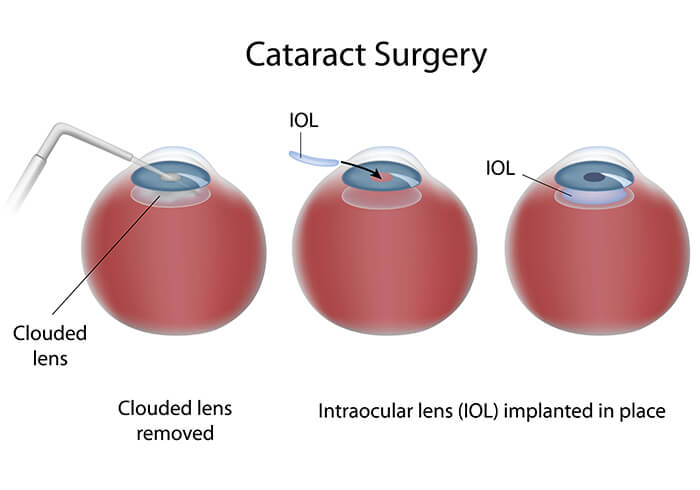Cataracts
If your vision has become blurry, cloudy, or dim, or objects are not as bright or colorful as they used to be, you may have developed a cataract in one or both eyes. Many people say vision with cataracts is similar to looking through a dirty car windshield or a fogged-up window.
Since cataracts develop gradually over time, you may not notice any changes in your vision at first. As cataracts progress, you may find they interfere with daily activities such as reading, watching TV, playing golf, or driving.
Ultimately, cataract surgery is the best way to achieve clear vision. There is no medical treatment to reverse or prevent the development of cataracts. Once a cataract develops, the only way to see clearly again is to have it removed and replaced with an intraocular lens (IOL).
Advanced Eye Care, SC is proud to offer the latest in cataract surgery technology and advanced lens options.

What are cataracts?
Cataracts are accumulations of protein that build up within the lens of the eye as we age, which results in blurry vision. The lens is a transparent structure located behind the iris, the colored portion of your eye. The primary function of the lens is to bend rays of light to form a clear image on the retina. A cloudy lens can cause vision problems that disrupt daily activities and affect your quality of life.
Cataract Symptom Checker







What happens before cataract surgery?
A comprehensive evaluation is required before cataract surgery, as the health of your eye is a critical component of optimizing your cataract surgery outcome. We recommend following these steps before your cataract evaluation:
- Do not wear any contact lenses for a minimum of 2 weeks before your appointment. Wear eyeglasses instead.
- Begin using lubricating eye drops. Dr. Kisla recommends either Systane Ultra, Refresh, or Retaine MGD. Use 2 to 4 times a day to increase cornea hydration.
- If you are currently receiving treatment for dry eye disease, continue all recommended treatment plans until advised differently.
After your cataract evaluation is complete, you’ll schedule another visit for additional testing, the date and time for your surgery, and all necessary follow-up visits. Your surgeon will also discuss your options for the best type of artificial lens implant.
What happens during cataract surgery?
Cataract surgery typically lasts between 10 to 20 minutes. The procedure is performed under a local anesthetic, which numbs the eye area. Your surgeon will make an incision on the surface of your eye that is so small, stitches are rarely necessary. The cloudy lens will then be removed through a small tube. Once the cataract is gone, a new artificial lens will be put into your eye.
What happens after cataract surgery?
You should have someone available to drive you home the day of the surgery, as it’s not safe to operate a vehicle with limited vision. After your surgery is complete, we’ll schedule a follow-up visit within the first 24 hours. Eyesight is usually blurry after cataract surgery, but your vision will clear dramatically within a few days. Most people are able to return to normal activities within 48 hours, including showering, driving, shopping and cleaning.
For the first two weeks, the eye will need extra protection. You should always wear UV-A/B blocking sunglasses while outside during the day. For three to four weeks after surgery, drops will need to be placed in the surgical eye regularly. After six weeks, your eye should be completely healed, and your vision restored. Cataract surgery is a once-in-a-life-time procedure since cataracts do not grow back.
See the World Through Different Lenses
Click the blue circles below to simulate vision before and after cataract surgery. Explore the difference between standard and lifestyle lens options to see how each could enhance your visual clarity!
Glaucoma Treatment During Cataract Surgery
For patients with combined cataract and mild to moderate open-angle glaucoma, we are pleased to offer the latest technology in glaucoma treatment. The iStent is the smallest medical device ever approved by the FDA. It is placed in your eye during cataract surgery and is so small that you won’t be able to see or feel it after the procedure is over.
iStent is designed to improve aqueous outflow of fluid from your eyes to help control eye pressure in glaucoma patients. Only your doctor can determine if iStent is right for you. For more information about iStent, click here.
Lens Choices
Basic Lens
For more than 30 years, doctors have treated cataracts by replacing them with a conventional IOL, which allows you to focus clearly at one distance only. Typically, patients would choose to have the doctor aim for the best distance vision with the understanding that glasses would still be needed for close work, such as reading.
Multifocal Lens
Multifocal lenses work by using various optical zones on the surface of the lens. These optical zones have different powers which bring into focus your vision at multiple distances – near, intermediate, and distance. A multifocal lens offers you the best chance at freedom from glasses, though you may be more comfortable with readers at very near distances or in dim lighting.
Astigmatism Correction
For patients with astigmatism who are having cataract surgery, you now have an additional option — an IOL that makes it possible to treat the cataract and correct your astigmatism at the same time.
Light Adjustable Lenses
Light Adjustable Lenses (LALs) are a significant advancement in cataract surgery, providing a level of precision that traditional intraocular lenses (IOLs) cannot match. Unlike standard IOLs, LALs can be fine-tuned after implantation through a specialized light treatment, allowing for adjustments that enhance your vision. This personalized approach ensures that your eyesight meets your individual needs, resulting in optimal clarity and satisfaction.
If you want to learn more about the life changing procedures involved in modern cataract surgery, we will be happy to answer all your questions. Although most insurance companies cover the cost for removal of your cataract, no insurance company will pay the additional amount charged for advanced technology lenses or femtosecond cataract surgery. If you are interested in any of these products or services, please understand that you will pay an additional fee per eye.



